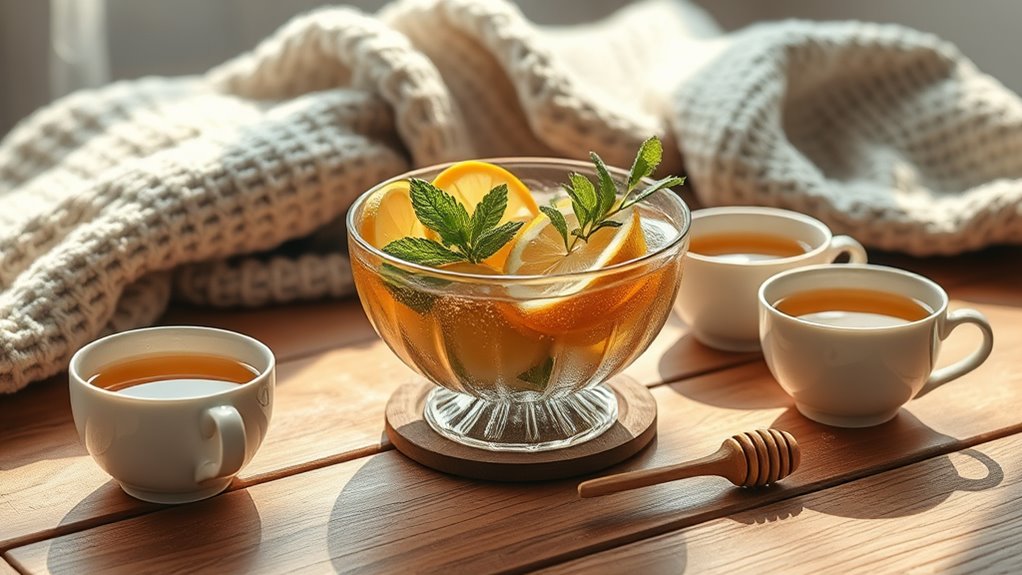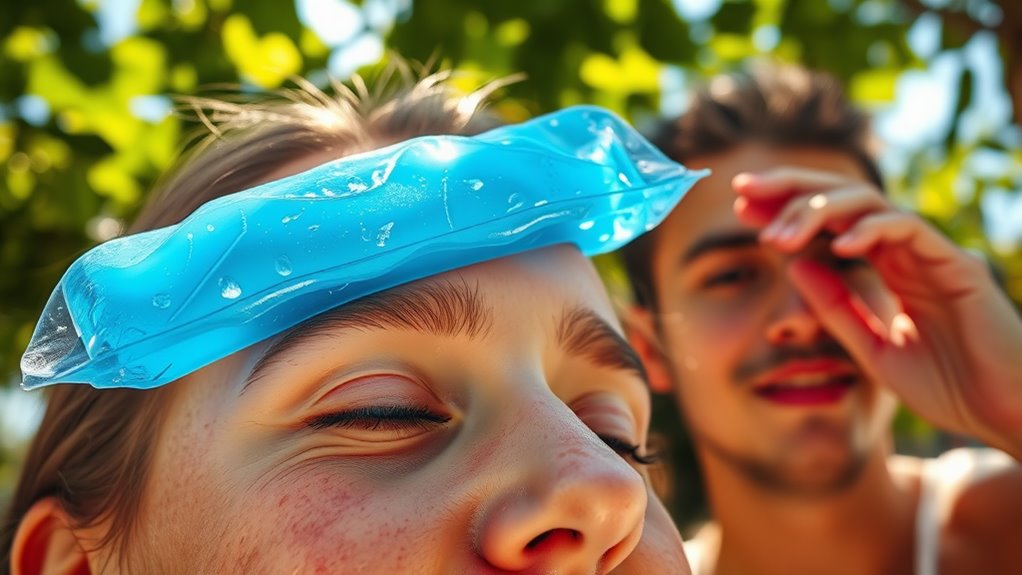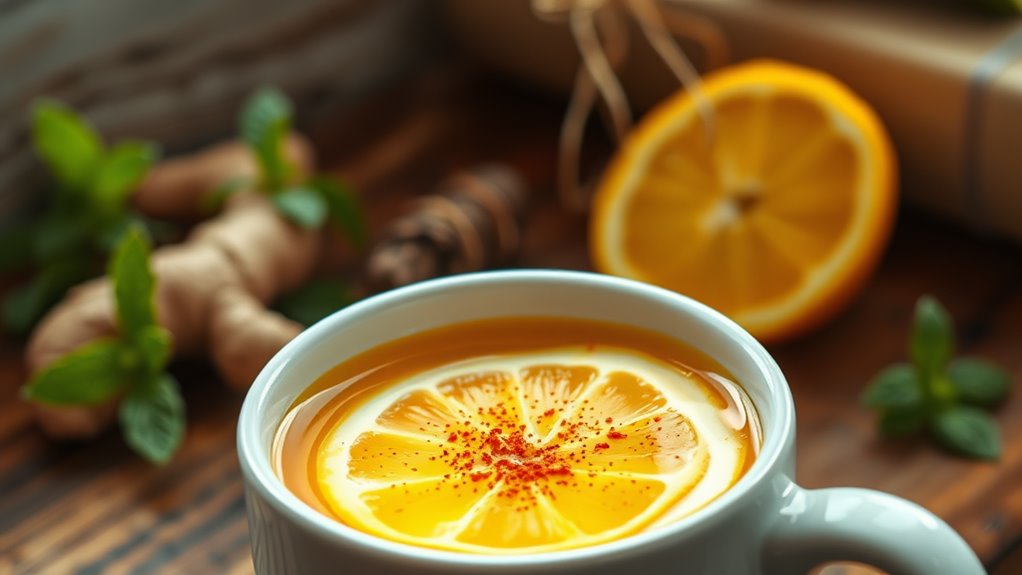A Gentle Way to Lower Fever Using Natural Ingredients
When you’re dealing with a fever, it can feel overwhelming trying to find relief. A gentle approach using natural ingredients may offer the comfort you need. By focusing on hydration and herbal remedies, you can support your body’s healing process without resorting to harsher medications. But what specific herbs and techniques can help? Let’s explore some effective strategies to lower your fever and promote comfort during your illness.
Understanding Fever and Its Causes
Fever is your body’s natural response to infection or illness, acting like a protective shield against harmful invaders. When you have a fever, your immune system ramps up its defenses, trying to eliminate the source of the problem. Common culprits include viruses, bacteria, and inflammation, which can trigger your body’s thermostat to raise your temperature.
To help manage your fever at home, consider fever relief home remedies like ginger tea, which can promote sweating and help cool you down. Herbal infusions, like chamomile or peppermint, can also provide soothing effects. Using cold compresses on your forehead or wrists might offer additional comfort. Additionally, it’s important to remember that effective home remedies can provide relief and comfort during a fever.
Hydration: The Key to Lowering Fever
When you’re battling a fever, staying hydrated is crucial.
Water helps regulate your body temperature and supports your immune system in fighting off illness.
Consider herbal teas or broths as tasty alternatives that can also boost your hydration efforts.
Importance of Water Intake
While many focus on medications to lower fever, one often overlooked remedy is proper hydration. When you’re running a fever, your body loses fluids more rapidly, which can lead to dehydration.
Staying hydrated is crucial because water helps regulate your body temperature, supports immune function, and flushes out toxins. Make sure you drink plenty of water to replenish lost fluids and keep your body cool.
Simple signs of dehydration include dry mouth, fatigue, and dark-colored urine, so keep an eye out for those. Aim for at least 8 glasses of water a day, or more if you feel particularly unwell.
Herbal Hydration Options
What better way to stay hydrated during a fever than through herbal teas and infusions? These beverages not only quench your thirst but also offer soothing properties.
Chamomile tea can help relax your body, while peppermint lifts your spirits and may even aid digestion. Ginger tea is another excellent choice, as it warms you up and helps fight inflammatory processes.
For a refreshing option, try making a hibiscus infusion, which is rich in antioxidants and can help lower blood pressure. Don’t forget to sweeten your herbal teas with honey, which has natural antibacterial properties.
Herbal Remedies to Consider
If you’re looking for natural ways to ease a fever, herbal remedies can be a powerful ally.
Consider using ginger, which has anti-inflammatory properties and can help reduce body temperature.
Peppermint, too, is great; its menthol content can create a cooling sensation and promote sweating, helping to lower fever.
You might also try elderflower, known for its ability to stimulate sweating and immune response.
Chamomile is another excellent option; it soothes and promotes relaxation, making it easier for your body to fight off illness.
Lastly, consider using turmeric, thanks to its powerful anti-inflammatory effects.
Incorporating raw honey and ginger not only enhances flavor but also may provide additional benefits in supporting the immune system.
Always consult with a healthcare professional before trying new remedies, especially if you have underlying conditions or are on medication.
Cooling Techniques for Comfort
When you’re feeling the heat of a fever, there are several cooling techniques you can try for relief. Applying herbal compresses, staying hydrated, and taking cool baths can make a significant difference in your comfort level. Additionally, targeting specific pulse points on your body, such as your wrists and neck, can enhance the cooling effect and provide rapid temperature reduction. Let’s explore how these methods can help you cool down naturally.
Herbal Compress Application
Although fever can be uncomfortable, using an herbal compress can provide a soothing, natural way to lower your body temperature and promote relaxation.
To create your herbal compress, steep a combination of calming herbs like chamomile or peppermint in hot water. Once it cools slightly, soak a clean cloth in the infusion, wring it out, and apply it to your forehead, wrists, or neck. These areas are effective for cooling as they contain prominent blood vessels.
You can also gently rewarm the cloth and reapply it as needed. Remember, this method not only helps with heat but also enhances your sense of comfort, allowing your body to focus on healing while you enjoy the soothing aroma of the herbs.
Hydration and Cool Baths
Along with herbal compresses, staying hydrated and taking cool baths are effective techniques to help lower fever and promote comfort. You need to focus on drinking plenty of fluids and using the right methods for cooling down.
Here are three simple tips:
-
Drink Water: Aim for at least eight glasses of water daily to stay hydrated. Herbal teas and clear broths are great alternatives too.
-
Take Cool Baths: Soaking in cool, not cold, water can help bring your body temperature down.
-
Use a Damp Cloth: Apply a cool, damp washcloth to your forehead and pulse points to enhance comfort.
These techniques will help you feel more at ease while your body fights off illness.
Diet Adjustments That Help
While you might typically reach for over-the-counter medications to lower a fever, adjusting your diet can also play a significant role in natural relief.
Focus on foods that promote healing and combat inflammation. Incorporate plenty of fruits and vegetables, particularly those rich in antioxidants like berries and leafy greens. Foods high in healthy fats, like avocados and nuts, can provide essential nutrients for your body.
Consider sipping on bone broth or herbal teas, which not only hydrate but also help nourish your system. Limit processed foods and sugar, as they can weaken your immune response.
Keeping your meals light and easily digestible makes it easier for your body to focus on recovery rather than digestion, helping you feel better faster. Additionally, maintaining a sustainable diet that supports liver health can enhance your body’s natural ability to combat illnesses.
When to Seek Medical Attention
Knowing when to seek medical attention is crucial, especially if your fever persists or worsens despite your efforts to manage it naturally.
Recognizing when it’s time to consult a healthcare professional can help prevent complications.
Here are three key situations to watch for:
-
High Fever: If your temperature exceeds 103°F (39.4°C), especially in adults, it’s time to call a doctor.
-
Extended Duration: If your fever lasts more than three days without any improvement, seek medical advice.
-
Additional Symptoms: Pay attention to severe headaches, neck stiffness, rash, or difficulty breathing.
These signs can indicate a more serious underlying issue that needs quick intervention.
Trust your instincts; acting early can lead to better outcomes.





